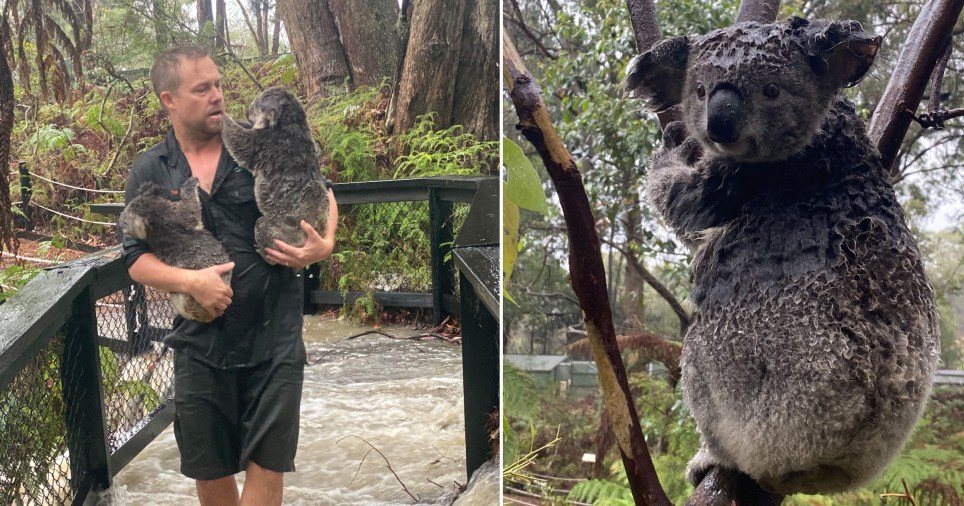Animals
The Same Koalas That Survived Australia’s Fires Are Now Being Rescued From Flash Floods
Torrential rain turned into the worst floods to hit Australia in months as cyclone season begins.

(TMU) — From one extreme to another—koalas and other wildlife that escaped the devastating bushfires of Australia are now needing to be rescued from the worst floods to hit Australia in months as the cyclone season begins.
Drenched koalas were carried to safety after thunderstorms and heavy rain struck parts of the island nation’s east coast. Although the rain brought relief to drought stricken areas and gave firefighters a desperately needed break from battling some of the fires, the floods come with the threat of landslides, water contamination, and dangerous conditions for rescuers trying to drive into forests to rescue injured animals.
The worst bushfire season on record started in September 2019 and badly affected the koala population. According to the government, koalas could soon be listed as endangered after many burned to death and those that survived face starvation thanks to the destruction of their natural habitat.
Koalas and other native animals had to be rescued at the Australia Reptile Park in New South Wales as the heavy rains caused flooding on Friday. Park director, Tim Faulkner, said:
“This is incredible, just last week, we were having daily meetings to discuss the imminent threat of bushfires. Today, we’ve had the whole team out there, drenched, acting fast to secure the safety of our animals and defend the park from the onslaught of water. We haven’t seen flooding like this at the park for over 15 years. The contrast between the current bushfire crisis and this sudden flooding is striking. We are well-aware that a huge part of Australia is still burning and millions of animals are under threat.”
Having lost over 100,000 cattle in the brutal wildfires, farmers rejoiced when the rain came and helped dampen blazes and smoldering trees.
Farmer Stephanie Stewart said:
“What can I say, we are so lucky. Before this, dams were dry, and we were carting water and feeding stock for months. This has made life a lot easier on the land, that’s for sure. Now hoping it spreads and can ease the burden for so many other amazing farmers who have been and still dealing with this dreaded drought.”
Despite the flooding residents in Queensland, Victoria, and New South Wales welcomed the rain while those in South Australia hoped it would reach them soon. Queensland’s major highways had to be closed and thousands were left without power in New South Wales after Friday night’s storms. Showers and thunderstorms are still forecast for the weekend, the Bureau of Meteorology has confirmed.
https://twitter.com/VeronicaKoman/status/1219095127148220416
New South Wales fire services welcomed the rain which would help in controlling the 75 fires still burning in the state. Around 25 fires still to be contained.
Reinforcements from both the New Zealand Defense Force and Fiji will be joining teams and specialists sent by other countries including Japan and the United states.
While Australian Prime Minister Scott Morrison and his conservative administration continue to downplay the role of human activity in climate change, some say the changing climate Australia has in fact increased the frequency and severity of what scientists call “fire weather”—periods of high fire risk due to a combination of higher temperatures, low humidity and rainfall, and strong winds. A combination putting 26.4 million citizens at risk and vulnerable to fires amid warnings that many Australians could become “climate refugees” as the Earth’s temperature continues to rise.
NASA confirmed earlier this week that smoke from the wildfires has circumnavigated the globe, returning to its place of origin.
In a statement, NASA also said that the smoke from Australia’s fires had a dramatic impact on New Zealand by “turning the skies hazy and causing colorful sunrises and sunsets.” NASA also highlighted the fact that the fires in Australia could cause global damage, saying that the “unprecedented conditions that include searing heat combined with historic dryness” have led to an erratic weather phenomenon called “fire clouds.” These clouds allow smoke to travel up to 5 miles high from where it can disperse miles away from where it originated.
Since the start of the bushfires 29 people and an estimated one billion animals have died while around 2,500 homes and over 16 million acres of bushland has been destroyed.
By Jade Small | Creative Commons | TheMindUnleashed.com
Typos, corrections and/or news tips? Email us at Contact@TheMindUnleashed.com
